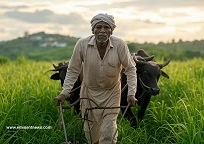Several regions around the world are currently experiencing locust outbreaks as of May 2025 :
- Africa: Outbreaks have been reported in Sudan, Eritrea, Algeria, Libya, and Tunisia . The desert locust outbreak that began in the southern Sahara has expanded to Northwestern Africa . Spring breeding in Algeria, Libya, and Tunisia may lead to small groups of locusts from May to June .
- East Africa: In early 2020, East African nations faced a major desert locust outbreak, which was considered the worst in decades .
- Arabian Peninsula: Locust swarms have also affected the Arabian Peninsula .
- South Asia: Swarms have spread through Iran, Pakistan and India .
Desert locusts are a major threat because they are highly destructive and migratory . A single swarm can travel up to 90 miles a day and contain as many as 80 million locusts, which can consume the same amount of food in a day as 35,000 people . These swarms ravage crops, trees, and pastureland, causing significant damage to food security and livelihoods . Climate change is considered a key factor in the current locust upsurge, with unusually wet weather patterns creating favorable breeding conditions .
What causes locust plagues worldwide ?
Locust plagues are influenced by a combination of environmental factors and locust behavior . Here’s a breakdown of the causes:
- Favorable Weather Conditions:
- Increased Rainfall: Unusually heavy rainfall and cyclones create conditions that support locust population growth and swarm formation .
- Vegetation Growth: Excessive rainfall promotes vegetation growth, providing locusts with a plentiful food supply, which allows their populations to expand rapidly .
- warmer oceans: Experts fear that locust swarms will become more common as oceans warm and more frequent tropical storms create favorable breeding conditions .
- Climate Change:
- Rising Temperatures: Increase the areas under threat from locusts .
- Extreme Weather Events: Climate change is expected to increase the frequency of extreme weather events like cyclones and intense rainfall, which can trigger locust outbreaks .
- Locust Behavior and Biology:
- Solitary to Swarming Transition: Locusts can exist in two phases: solitary and gregarious (swarming). Changes in environmental conditions and population density can trigger a shift from the solitary to the swarming phase .
- Collective Motion: Locusts in swarms exhibit collective motion, where they move together in a coordinated manner. Vision is important .
- Other contributing factors:
- Global warming: Global warming is likely the main cause of locust plague outbreak in recent decades driving egg spawning of up to 2–400,000 eggs per square meter .
- Winds: Winds and rainfall patterns have facilitated northward movement of desert locusts from southern Algeria, northern Mali, Niger and Chad .
Are there methods to control locust populations effectively?
Yes, there are several methods to control locust populations effectively, including:
- Early Warning Systems and Monitoring:
- Desert Locust Information Service (DLIS): The DLIS continuously monitors the global desert locust situation, analyzes data, and provides forecasts, early warnings, and alerts regarding breeding and migration .
- Satellite Monitoring: Satellite imagery and remote sensing are used for early detection and monitoring of locust swarms. Platforms analyze satellite data to provide real-time information on vegetation health, soil moisture, and swarm movement .
- Mobile Apps: Farmers can report locust sightings and receive alerts through smartphone applications .
- Spraying Techniques:
- Aerial Spraying: Aerial spraying is an effective method for controlling large locust swarms, using GPS-guided drones and aircraft for accurate pesticide application .
- Precision Spraying: Low-volume precision spraying, especially in areas inaccessible to ground vehicles and airplanes, can be conducted .
- Biopesticides:
- Metarhizium acridum: A fungal species that shows significant potential as a biopesticide, offering a safe and effective option for locust control .
- Sustainable Farming Practices:
- Crop Diversification: Planting a variety of crops reduces the risk of total loss and can deter locust feeding .
- Intercropping: Growing multiple crops in the same field can create natural barriers to locust movement .
- Physical and Mechanical Controls:
- Techniques such as digging up eggs, handpicking, smoking, and baiting can be employed .
- Community Engagement:
- Community-based monitoring networks provide real-time information on locust movements, empowering farmers to take proactive measures .
- Modeling and Prediction:
- Computational models using weather forecast data predict swarm movements, enabling targeted control measures to control locust plagues

























